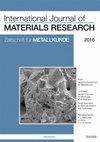复合增材制造钢头组织演变的研究
IF 0.7
4区 材料科学
Q4 METALLURGY & METALLURGICAL ENGINEERING
引用次数: 0
摘要
摘要:考虑到搅拌摩擦加工(FSP)在细化组织晶粒、产生等轴晶粒和减少冶金缺陷方面的有利作用,采用气体金属弧焊-电弧增材制造(GMAW-WAAM)技术生产的添加剂头(AB)进行了搅拌摩擦加工。这是因为沉积的添加剂头在液固转化过程中经常出现收缩、空洞、凝固开裂等缺陷。本研究采用GMAW-WAAM技术制备了横向重叠度为32 %的低碳钢双道添加剂头,然后在重叠区(OR)通过FSP进行杂交。利用ABAQUS软件建立模型,对熔珠沉积过程中的峰值温度进行估计,并对熔珠进行FSP处理。采用光学显微镜、扫描电镜、电子背散射衍射和透射电镜对样品进行微观结构分析。沉积的添加剂头的OR组织以铁素体和贝氏体的结合为主,而杂化添加剂头(HAB)的组织以铁素体和马氏体的结合为主。进一步分析表明,FSP对OR的影响表现为晶粒细化从5.56 µm到3.50 µm,低角度晶界从35.4% %减少到10.6 %。随着搅拌摩擦加工区马氏体分数的增加,重叠区贝氏体分数的减少,观察到连续的动态再结晶。经FSP处理后,籽粒平均取向偏差由AB的1.001降低到0.608。显微硬度测试表明,FSP后硬度有所下降。本文章由计算机程序翻译,如有差异,请以英文原文为准。
Investigation of microstructural evolution in a hybrid additively manufactured steel bead
Abstract Motivated by the beneficial effects of friction stir processing (FSP) for microstructural grain refinement, equiaxed grain production, and minimizing metallurgical defects, additive bead (AB) produced by the gas metal arc welding-wire arc additive manufacturing (GMAW-WAAM) technique was subjected to FSP. This was because deposited additive bead often develops defects such as shrinkage, voids, solidification cracking, during liquid to solid transformation. In this study, a low carbon steel double pass additive bead with 32 % lateral overlap was fabricated by the GMAW-WAAM technique followed by hybridization through FSP in the overlapped region (OR). The peak temperature estimation during bead deposition and FSP on bead was done through modeling by using ABAQUS. The microstructural analysis was carried out by using optical microscopy, scanning electron microscopy, electron backscattered diffraction, and transmission electron microscopy. The microstructure of OR of deposited additive bead is dominated by a combination of ferrite and bainite while that of hybrid additive bead (HAB) is dominated by a combination of ferrite and martensite. Further, the analysis revealed the effects of FSP on the OR in the form of grain refinement from 5.56 µm to 3.50 µm and a decrease in the low angle grain boundaries from 35.4 % to 10.6 %. The continuous dynamic recrystallization is observed since the bainitic fraction in the overlapped region decreased along with an increase in the fraction of martensite in the friction stir processed zone. The kernel average misorientation is observed to decrease after FSP from 1.001 of AB to 0.608. The microhardness test reveals the decrease in the hardness after FSP.
求助全文
通过发布文献求助,成功后即可免费获取论文全文。
去求助
来源期刊
CiteScore
1.30
自引率
12.50%
发文量
119
审稿时长
6.4 months
期刊介绍:
The International Journal of Materials Research (IJMR) publishes original high quality experimental and theoretical papers and reviews on basic and applied research in the field of materials science and engineering, with focus on synthesis, processing, constitution, and properties of all classes of materials. Particular emphasis is placed on microstructural design, phase relations, computational thermodynamics, and kinetics at the nano to macro scale. Contributions may also focus on progress in advanced characterization techniques. All articles are subject to thorough, independent peer review.

 求助内容:
求助内容: 应助结果提醒方式:
应助结果提醒方式:


